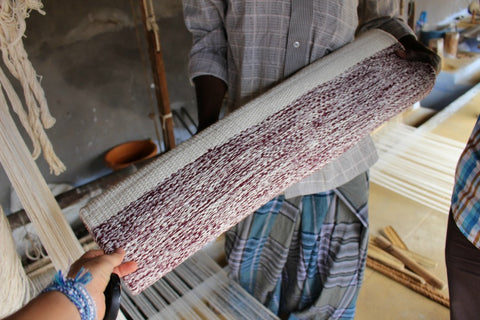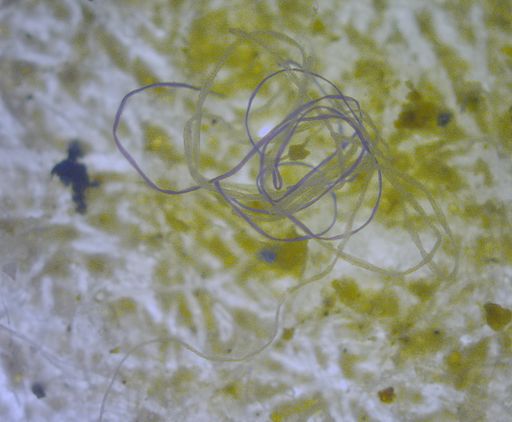Oxymoron
- a figure of speech in which apparently contradictory terms appear in conjunction
eg. Ecofriendly Microfiber [insert yoga product here]
I would guess that not many yoga practitioners in the world would spend their time Googling Yoga Towels to see what comes up in the search results.
I'm guessing there are even fewer Ashtanga practitioners that also sell Organic yoga rugs that would be doing the same thing.
In fact there is a really good chance I'm the only one who would care about such a thing and then be looking into it which is why I'm the only one (I think?) who noticed one very interesting fact.
There is actually no such thing as an Organic Microfiber Yoga Towel.
I won't keep you in suspense any longer. The reason is because of what Microfiber actually is.
Microfiber is one of those words that has been around so long that we use it without fully understanding what it is. At least I did. So what exactly is Microfiber?
According to Canadian environmentalist David Suzuki
"They (Microfibers) are made from petrochemicals. The polyester and polyamide fabric strands are 100 times finer than human hair. That's what makes them so good at lifting dirt, grease and dust without cleaning chemicals. Problem is, they are made from a nonrenewable resource and do not biodegrade. And only those made from polypropylene are recyclable. - Davidsuzuki.org"
And since Microfiber is not a natural material it can't be organic and this is becoming a big big problem.
In my experience, and a key principle I teach about in my Strong Foundations email series, the more you move away from nature you the more likely you encounter unanticipated problems.
One of those unanticipated problems with using Microfiber is just starting to come to light and it's bad. Really bad.
The Day I Quit Using Plastic Apparel. February 22 2017.
Just the day before, February 21st, I was researching Microfiber and what effects it has on the environment. I came across an article in the Guardian from 2014 about ecologist Mark Browne. He had been examining shorelines around the world when he discovered that
"85% of the human-made material found on the shoreline were microfibers, and matched the types of material, such as nylon and acrylic, used in clothing" - The Guardian
The next day on the news feed of my phone (which normally I avoid) was an article announcing a new study that just came out from the IUCN (International Union for the Conservation of Nature).
The study: Invisible plastic particles from textiles and tyres a major source of ocean pollution came to the conclusion that
"Tiny plastic particles washed off products such as synthetic clothes and car tyres could contribute up to 30% of the ‘plastic soup’ polluting the world’s oceans and – in many developed countries – are a bigger source of marine plastic pollution than plastic waste" - IUCN
The take home points from the study are:
It is very likely that:
• Losses of primary microplastics from commercial and household activities into the environment is in the order of 3.2 Mton/year.
• The greatest contributors to these losses are abrasion of tyres while driving and abrasion of synthetic textiles while washing, i.e. diffusive losses during use/maintenance phase.
• Release of primary microplastics is a significant source of plastic into the ocean. • In high income countries with adequate waste management, primary microplastic release equals or overweighs the releases from mismanaged plastic wastes. However in lower income countries plastic releases from mismanaged wastes still is the main source of plastic release into the oceans
Then on March 1st the Story of Stuff Youtube channel released a video they have been working on the last 8 months .
This video sums up pretty well what the problem is with using synthetic materials.
.
5 Actionable Steps You Can Take To Lessen Microfiber Pollution.
I have a Patagonia fleece that I love. I've always been a big supporter of Patagonia and their founder which I go into detail in my Slow Fashion Email Series. After learning about how washing these synthetic products was causing this pollution I started to look at all the tags on my clothes. The Patagonia one is made out of what they call synchilla. Ok so it's synthetic. I thought well I wash it very infrequently since it doesn't really get dirty.
Then I thought about my yoga clothes. I wash those almost every day! Which brings me to the first step you can take right now.
1. Wash Your Plastic Clothes Less
Obviously this is going to be more difficult with microfiber yoga towels, synthetic yoga pants & synthetic yoga shorts. Since we sweat so much in practice they can get smelly pretty quick. For this problem see steps 2 & 3. I'm referring to your everyday clothing. The less you wash it the less the fibers go down the drain so just as we suggest in for washing yoga rugs only wash them when it's necessary not just because you used it once. This also saves on water, detergent cost and your time.
2. Buy Yoga Products Made Of Natural Materials
“The findings of this report have important implications for the global strategy to tackle ocean plastic pollution, which currently focuses on reducing plastic waste,” says Joao de Sousa, Marine Project Manager, IUCN’s Global Marine Programme. “They show that solutions must include product and infrastructure design as well as consumer behaviour. Synthetic clothes could be designed to shed fewer fibres, for example, and consumers can act by choosing natural fabrics over synthetic ones”
You don't have to use these technical garments & towels. They haven't been around that long & people were practicing yoga just fine (and actually even better) without them. The natural fibers of cotton will also breakdown in the wash but with one key difference. Cotton is biodegradable.
When choosing yoga clothing look for the highest amount of organic cotton in the product. Most will not be 100% organic cotton but have a small amount of spandex in them to give a tighter fit.
We have organic cotton pants & shorts coming soon and have been using the samples already in practice.
When I gave a pair to my teacher Fiona she said "Oh these are like the ones we used to practice in". Then when I took the sample pair away from my girlfriend to give to the designer she said "where did those pants go? Those are my favourite ones!"
When it comes to a yoga towel then the best choice is a yoga rug. It's how it was done before the invention of the microfiber towel and since you will be washing it often the best choice is cotton. I have a lot of information about all of this on the website but the basic principle is always the same. Closer to nature the better for nature and the practitioner. They cost more but that's because they are made by master weavers and take 3 hours to create.
Check the labels and materials closely. They are often hidden in the back pages and under weird names you can't understand.
3. Consider The Guppy Friend
I'm sure you aren't going to go an throw out all your clothes just because you read this post. It doesn't solve the problem since they just end up in the landfill instead of the ocean anyway. The real solution is to stop buying them.
For what we have there is a company that has developed a product called "The Guppy Friend". It's a bag that you can put your plastic clothes in so when you wash them the bag catches the microfibers.
Animation_GUPPY_final from LANGBRETT / kosmos on Vimeo.
Learn more about Guppy Friend & where to buy the bags click here
4. Buy Less

The problem with 99.99% of companies that sell yoga products is they don't practice yoga. They start their companies because they want to make money and that is the primary goal that drives their actions & thoughts.
Ekaminhale was started after 9 years of a daily Ashtanga Yoga Practice. Just like the founder of Patagonia I had no intention of doing this. Just like Yvonne I already had a deep connection and love of nature through both the place I grew up and the breath in my practice. I explain all this in the email series but what I want to point out is that our actions and motivations for having a business are different than those who don't have this experience. Business can be a powerful force and it has to be profitable to exist. My intention is not to be profitable so I can have more things. I want less things. My intention is to be profitable so I can help protect nature and teach people the happiness they can experience when they align themselves with her.
5. Tell Others
I remember people saying that they preferred Microfiber Yoga Towels over the Yoga Rugs for reason's like weight and price. I was selling Yoga Rugs and couldn't argue with them. Seemed like good reasons.
So if I didn't know about this issue of pollution then how many other yoga practitioners were there that also didn't know?
I would say most of them. So now that you know please let others. Share this post or any of the videos with a friend that you think would care.
Technology Out. Nature In.

I've found in so many circumstances from sitting, to the footwear I use, the place I live, the type of Yoga I practice or the products I sell that the closer I can stay to nature the the less problems I have.
Natural methods are time tested. Technological ones....well you see what can happen.
It's a concept I learned from the book Antifragile by Nassim Taleb. New technologies can have easily seen small benefits but often hidden massive negative ones. The only way to know for sure is by the passage of time. The methods that stick around generation after generation are the most reliable since they bypass opinion's.
To create yoga rugs weaver's use looms in the same way that generations before them did. It's a beautiful, peaceful and artisanal process. I know this because we went there to see it for ourselves and meet the people who make the rugs.
My heart sank when I found out about Microfiber pollution. It is a crucial time for planet earth and reminds me of a quote that we had in our home growing up.
“Only when the last tree has been cut down, the last fish been caught, and the last stream poisoned, will we realize we cannot eat money.” - Cree Indian Prophecy
If we aren't going to help Mother Nature then who will?



